Wedgesail A18
A Dual Purpose Coastal Cruiser
By Chris Ostlind (aka ChrisO)
The new boat concept for the A18 canoe/trimaran evolved out of a design criteria
that had a specific goal in mind. Later, I discovered that the same boat, with
only a few changes, could be fashioned to allow for a very broad set of
applications that came to me only after I was well into the build process.
Initially, I was looking for a dual-use boat for families that could be built at
home by a reasonably accomplished builder with a stitch-and-glue or stripper
sea kayak or canoe project under his/her belt. In the past, I have designed and
built, as well as adapted from production models, many sailing canoes and sea
kayaks that had a reasonably good sailing component, but they were always,
primarily, paddled craft.
With this new boat I wanted to reverse the weighting of the design issues to
highly favor the sailing aspect and still retain a modest paddling function for
quiet waters.
Okay, it was more than that. I wanted to realize a real performance potential
with this boat that I had only flirted with in previous designs. Sea kayaks and
canoes can be sailed quite well up to a point and then the design deficiencies
of their hulls begin to control the potential for realized performance under
sail. Some of the hulls of paddled craft can sail better than others, of
course, but they still don't perform like a purpose designed sailboat. I wanted
to explore that potential in this boat.
I looked to a trimaran based on a highly modified canoe hull for the principal
solution. The tri offered a good many advantages over a monohull for this
exercise in that the main hull (vaka) would be very light which could then be
easily paddled and without a doubt it would be driven quickly due to weight and
the stability offered by a wide beam under sail.
I studied the hull design elements of all the best designers of trimarans as
well as the efforts of the better canoe designers to get a starting point for
the basic boat. I looked to get a hull shape that was a compromise design
between the Antrim 40,
http://www.antrimdesign.com/trimarans/40'racercruiser.html and
the John Winters designed, Quetico canoe.
http://www.greenval.com/quetico.html
|
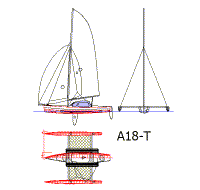
-
LOA 18'
-
LWL 17'8"
-
BOA (with amas) 15'
-
BOA (vaka) 36"
-
BWL 30"
-
Draft (board or Mirage up) 6"
-
Draft (board down) 40"
-
Displacement 800 lbs.
-
Sail area (main and jib) 218 sq. ft.
-
SA/D 39.69
-
Cp (vaka) .573
-
Cp (ama) .63
|
As wild as that differential seems to be, it wasn't long before a hull emerged
from my Rhino software that met all the basic criteria for the design and
nicely morphed the existing shapes of the chosen hulls.
I was looking for a boat from which an owner could get a tremendous amount of
use whether the wind was blowing or not. Since I have a family with two very
expensive teenagers, I wanted to squeeze as much from my boating dollar as
possible. Call me pragmatic, but it's a very real balancing act when faced with
the expenses of a family. At this point, the project sounded a lot like a
design that was headed for trouble.
I looked at the design over a period of many months, tweaked things often to
satisfy my misgivings and then decided to go ahead with the project to fully
explore the potential of a boat of this type. If it turned out that the concept
had too many flaws, I could always keep the boat off the market and just enjoy
it myself.
I reached out Jim Antrim for design review and corrective input on the hull
shapes, balance, rig and overall approach to the concept. Jim is very well
known for designing some incredibly fast multihulls and monohulls and his
vision and understanding of the application have been at the core of this
project since I did the initial drawings.
I was really happy when Jim returned the drawings with only minor corrections to
my original concept. The project was on and I was off to the NC router to cut
the marine ply panels.
While I was building the boat, I discovered that other folks had some very
strong opinions as to how it might be used and I got an earful from friends as
well as folks just dropping by my shop to see what I was doing.
|
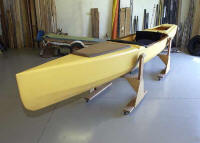
Vaka Bow

Vaka Profile
|
Because dual use was at the heart of this plan, the aka system and ama
attachment had to be easily managed, lightweight and purely functional for the
job of mounting the amas to the vaka. I had used take-apart aka tubes for all
my previous canoe and kayak rigs with great success, so I decided to apply the
same process to the scaled-up needs of the new boat.
Each aka tube comes apart in three pieces with a central unit firmly bolted to
the vaka hull and a single extension to each ama where they slip into a fitting
by means of a pinned ferrule. The ama fixture will mate with the vaka hull
fitting for trailering, but the amas can also be used on the water in that
fashion as a very stable canoe. If a small outboard is fitted, the boat takes
on an entirely new personality as a launch, fishing platform, duck hunting
hotel, etc. The closely fit amas also ensure that a family canoe outing can
virtually never end up as a capsize with scared little kids.
|
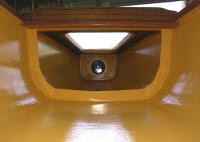
Aft Compartment
|
For practical and space limitation reasons, most home built projects kind of
top-out at around 17-18', I selected 18' as the most manageable for a build as
well as offering a good platform for a small family out on the water. Since I
had already gone beyond the length of a standard, two sheet plywood build, it
made complete sense to take it to 18'. The main hull is constructed from 1/4"
marine ply with 1/4" stripped cedar decks. The boat is glassed inside and out.
The full setup features amas that are just a touch under 16' in length to allow
the builder to crank out both hulls with a minimum of plywood expense. They are
constructed of 1/8" Okuome in the prototype but could also be built from a more
economical Aquatek or Hydrotek to keep costs down.
The rig for this project is directly from a Hobie 16 catamaran. I picked this
rig because they can be found everywhere in the world and are very well known
to sailors of beach boats as well as sail makers. This makes the boat universal
in its appeal.
I could have gone with one of the more high-tech rigs that are currently out
there on numerous beach catamarans, but none of them have the shear numbers to
be available to a builder of this boat as affordably as the Hobie 16 rig.
Certainly, if an owner wants to substitute a Nacra or Prindle rig it will work
just as well.
|
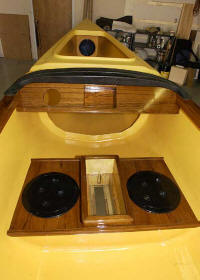
Over Dash Unit
|
With a furler on the jib, a simple topping lift, the main dropped and secured to
the boom and a weather cover hung over the boom from tramp to tramp and this
boat could comfortably sit on a mooring or a beach throughout the sailing
season, always ready for the owner to enjoy.
The prototype includes one feature that wasn't originally in the design
criteria. While I was getting ready to build and install the dagger board
trunk, a friend of mine, Kellan Hatch, had just completed a modification to one
of his boats to include a trunk for a Hobie Mirage drive unit. One look at his
transformed CLC kit boat and I started wondering if I could include that option
in my new boat.
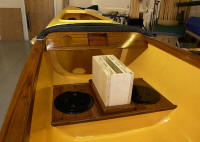
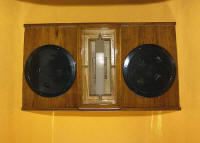
Daggerboard
Trunk
|
Up until then, my mental discussion had been whether or not the boat should have
a centerboard for beaching utility or a daggerboard for sailing efficiency.
When the Mirage came on the screen, the answer immediately swerved in the
direction of the daggerboard due to construction problems with a centerboard
and a Mirage in the same system. I solved the design issues with a convertible
trunk that is built to accept the Mirage and then also take a snugly fit insert
unit to allow the daggerboard to slide up and down as needed while providing
the strength to take the side loads of the foil under sail.
The A18 can be paddled by two from the traditional, fore and aft seating
positions that you would find in any canoe. It can also be driven from the main
compartment via the Mirage when used solo. Traditional canoe seating is
adjustable up, down, fore and aft as well as for pitch. The seats are removable
so that they can be used at campsites for extended utility.
|
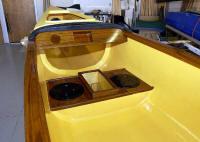
Main Compartment
|
The main hull is designed to accept a dodger unit that can be folded forward.
The dodger also has a full, snap-on Bimini cover to shield the sun over the
cockpit as well as removable zip-out windows for all-weather sailing or Mirage
peddling. With all sail and rudder controls led to the cockpit, the boat can be
successfully driven in all types of weather with reasonable comfort for the
sailor.
The solo sailor can also sleep aboard in the main hull in the area aft of the
trunk. The boat is wide enough to allow for a nice sleeping place along the
same comfort lines as a single mountaineering tent. Not palatial, but adequate
for a good sleep without feeling overly claustrophobic.
It is with these types of capabilities that this boat emerged as a WaterTribe
style coastal cruiser. Certainly, the boat will be fast on the water under
sail. If driven by two, the potential exists for one to rest while the other
drives. Very thin water can be handled by pulling the Mirage from the trunk and
pushing the boat with paddles. For passing under low bridges, the mast is
easily dropped in the fashion of beach cats . Likewise, the beam of the amas
can be slimmed-down to allow for any of the filters on the EC course.
As with any boat design that has to live in the realities of the two worlds of
human propulsion and sailing, there are compromises in this boat to that end. A
pure trimaran, would be much more narrow in the main hull to generate maximum
sailing speed. A more paddle/peddle craft would be much lighter and wouldn't
have to deal with the loads created by the large sail rig.
The criteria for a boat entered in one of these races is complex and its success
has everything to do with the on-course conditions during the event and how
those conditions are handled by the crew. I'd like to see prevailing westerlies
at 15-18 knots. Being able to plan for that weather window hasn't been
especially rewarding in the preceding years, so the compromises in overall
design start to kick-in.
In any event, this boat will serve as a fantastic coastal cruising vessel that
is capable of the odd, open water crossing of note when preparation is solid
and the crossing timed in a conservative fashion.
The A18 will be available as a set of plans as well as an NC-router cut kit for
the hulls. I'll probably not ship the hull kit with epoxy and glass as most
builders who are capable of taking on a build of this type already have a
favorite epoxy and glass combination that they prefer to use. The kits will be
manufactured and shipped by Waters Dancing Boat Kit Co. out of Canada, a very
high quality provider of kayak and canoe designs and kits.
http://www.watersdancing.com/waters/index.htm
There's an outside chance that the boat will also be built as a finished
production model, complete with trailer, as a drive away product. If that
happens, I'm probably a year away from pulling all the elements together for
that venture.
Constructive criticism is always a joy to have from experienced coastal
adventurers. Please feel free to fire away at the design elements of the
project on the WaterTribe Forum. I'll be an active participant and hope to
learn from fellow Tribe members and their comments or questions.
With the exception of exterior finish painting, the main hull is now complete
and has been pushed aside. Over the next month the amas will be completed, the
boat rigged and the sea trials will begin. Well, such as they can be called sea
trials in Salt Lake City.
I'll be taking the boat to Lake Powell in mid-September for a Messabout where
I'm going to cruise the lake with other boat builders. If you're in the
neighborhood, I hope to see you there and I'll be happy to take you for a ride.
As soon as the boat is complete, I'll supply Chief with some additional photos.
© Chris Ostlind 2004
|